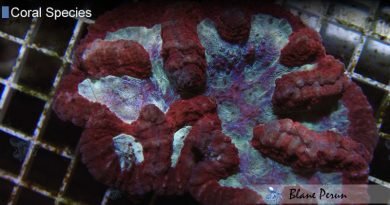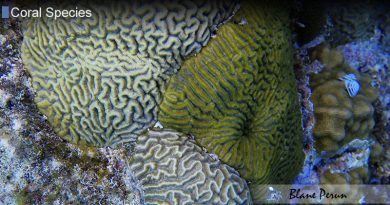Goniastrea
Table of Contents
Goniastrea is a genus of stony corals which belong to the family Merulinidae. These corals usually form massive colonies that are round or dome-shaped. A common trait is that these colonies have distinctive lobes protruding. The polyps extend only during the night.
These corals usually form massive or submassive colonies, with some even forming encrusting colonies. The shape is usually a dome or a sphere which is most often taller than it is wide. Corallites are usually grouped 4 to 6, depending on the species. The main characteristic of Goniastrea colonies is that they have palliform lobes which give them the appearance of lobed boulders.
The walls of the corallites, which are shared between more of them, are meandroid and they form valleys, ridges and mazes. Colonies can grow to 1 meter in height, although most species grow smaller than that. Polyps have a center and sometimes large collumela. Colors range depending on the species as well as habitat, from green to brown and mixes of colors are often seen. The polyps stay retracted during the day, exposing the skeleton structure and the corallites and they only extend during the night.
These corals can be found throughout the Indo-Pacific region. They can be found in the Red Sea, Gulf of Aden, East Africa coast, Indian Ocean, China Sea, West Pacific and Pacific Islands and South to Australia. These corals are zooxanthellate and, thus, they are rarely found at depths greater than 20 meters. They prefer shallow waters with little movement, and turbidity is a factor, with most species preferring turbid waters.
Notable species
Goniastrea species are not as common as with other members of the Merulinidae family. Most notable are G. australensis, G. favulus and G. retiformis. Just as the name suggests, G. australensis can be found in the Northern coast of Australia, Great Barrier Reef but Red Sea, China Sea and the Pacific. This species forms dome-shaped colonies with prominent lobes. These paliform lobes are finely toothed and they also have large collumelas. G. favulus does not exhibit prominent lobes, which the colonies being mostly shaped as boulders. The meandroid valleys form prominent mazes, making the colony resemble a brain. G. retiformis forms colonies which are usually less than 50 centimeters across, with paliform lobes and usually deep calices.
These species feed either heterotrophic or through the dinoflagellatae they host. These symbiotic microalgae, the zooxanthellae, create basic carbohydrates through photosynthesis. These symbionts can provide the colony with as much as 90 percent of the food needed, especially in habitats where light is abundant. In darker waters or during the night, the polyps extend their tentacles and feed on bacteria, tiny zooplankton or dissolved organic matter.
These corals reproduce sexually and asexually. The colonies are hermaphrodite so they contain both sexes. During mass spawning events, they release sperm and eggs. Some species such as G. favulus release the sperm through jets, while the eggs are negatively buoyant and adhere to the colony. In this case, self-fertilization often occurs, while in the case of Goniastrea aspera, both eggs and sperm are buoyant and cross-fertilization is more common.
Exploring the Fascinating World of Goniastrea: A Reef Builder’s Tale
Goniastrea, a genus of hard, reef-building corals, plays a pivotal role in our marine ecosystems. These corals, known for their resilience and diverse forms, contribute significantly to the structure and health of coral reefs. In this article, we’ll delve deep into the world of Goniastrea, exploring their unique characteristics, habitat, role in the ecosystem, and the challenges they face. Suitable for both the general public and those with a keen interest in marine biology, this article aims to enlighten and engage readers about these remarkable organisms.
Goniastrea’s Distinctive Traits
Identifying Goniastrea: Morphology and Structure
Goniastrea corals exhibit a fascinating array of morphologies. Typically, they are characterized by their massive, dome-shaped colonies, which can grow quite large in size. The corallites of Goniastrea, which are the skeletal cup structures housing the coral polyps, are distinctively meandroid. This means they form long, winding grooves and channels, a feature easily spotted by enthusiasts and researchers alike. These structures play a crucial role in the coral’s survival, aiding in feeding, respiration, and defense against predators.
Goniastrea Color Variations: A Spectrum Under the Sea
The color palette of Goniastrea is as diverse as its forms. These corals display a range of hues from pale browns to vibrant greens, often speckled with contrasting colors. This color variation is not just for show; it’s a direct result of the symbiotic relationship with zooxanthellae, microscopic algae residing within the coral’s tissues. These algae, vital for the coral’s nutrition, influence the coloration based on factors like light availability and water quality.
Habitat and Distribution: Goniastrea’s Realm
Goniastrea in the Wild: Preferred Environments
Goniastrea species are predominantly found in the Indo-Pacific region, thriving in a variety of marine environments. These resilient corals adapt to various conditions, from shallow lagoons to deeper reef slopes. Their ability to withstand different environmental stresses, like temperature fluctuations and varying salinity levels, makes them vital components of their ecosystems. Understanding their habitat preferences helps in conserving these essential reef builders.
Geographic Spread: Mapping Goniastrea’s Presence
Mapping the geographic distribution of Goniastrea reveals a wide range across the tropical and subtropical waters. They are notably present in the Great Barrier Reef, Red Sea, and parts of the Indian Ocean. This widespread presence underscores their ecological importance, as they provide habitat and food for a myriad of marine species, contributing to the biodiversity of these regions.
Ecological Role and Importance
Goniastrea as a Keystone Species
Goniastrea’s role in the marine ecosystem is profound. As keystone species, they provide critical habitat and resources for a multitude of marine organisms. Their complex structures offer shelter and breeding grounds for fish, invertebrates, and other coral species. This biodiversity hotspot is not just crucial for marine life; it also supports human livelihoods through fisheries and tourism.
Symbiotic Relationships: The Interconnectedness of Goniastrea
Symbiosis is at the heart of Goniastrea’s existence. The symbiotic relationship with zooxanthellae algae is fundamental for their survival. These algae perform photosynthesis, providing essential nutrients to the coral. In return, the coral offers the algae a protected environment and access to light. This relationship exemplifies the intricate connections within marine ecosystems, highlighting the importance of preserving these environments.
Challenges and Threats to Goniastrea
Environmental Stressors: Impact on Goniastrea Health
Goniastrea, like many coral species, faces significant challenges from environmental stressors. Climate change, leading to ocean warming and acidification, poses a severe threat to their survival. These conditions can lead to coral bleaching, where the symbiotic algae are expelled, leaving the coral vulnerable and often leading to mortality. Understanding and mitigating these stressors is crucial for the conservation of Goniastrea and the ecosystems they support.
Human Impacts: The Role We Play
Human activities have a profound impact on Goniastrea populations. Pollution, overfishing, and destructive fishing practices, along with coastal development, are major threats to their habitats. It’s essential to recognize our role in these challenges and work towards sustainable practices and conservation efforts to protect these vital marine organisms.
FAQs on Goniastrea
- What distinguishes Goniastrea from other coral species? Goniastrea is distinguished by its meandroid corallite structures and massive, dome-shaped colonies. These characteristics, along with their diverse coloration and resilience to various environmental conditions, set them apart from other coral species.
- How do Goniastrea corals contribute to marine ecosystems? Goniastrea corals contribute significantly to marine ecosystems by building reef structures that provide habitat and resources for a wide range of marine life. They also play a role in nutrient cycling and support biodiversity, making them crucial for the health of marine ecosystems.
- What are the main threats to Goniastrea populations? The primary threats to Goniastrea populations include climate change, leading to ocean warming and acidification, pollution, overfishing, and destructive human activities. These factors can cause coral bleaching, habitat loss, and reduced resilience, posing significant risks to their survival.
- Can Goniastrea corals be found in aquariums, and are there specific care requirements? Yes, Goniastrea corals can be kept in aquariums. They require stable water conditions, moderate lighting, and good water flow to mimic their natural habitat. Maintaining proper water quality and temperature is crucial for their health and growth in captivity.
- How can individuals contribute to the conservation of Goniastrea and other coral species? Individuals can contribute to coral conservation by supporting sustainable fishing practices, reducing carbon footprints to combat climate change, participating in reef clean-up activities, and educating others about the importance of coral ecosystems. Supporting conservation organizations and research initiatives is also beneficial.




